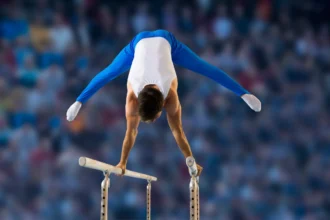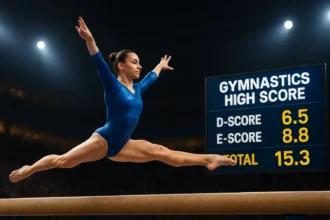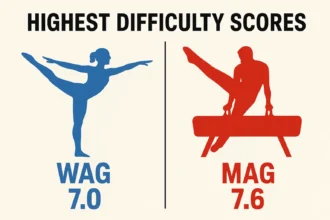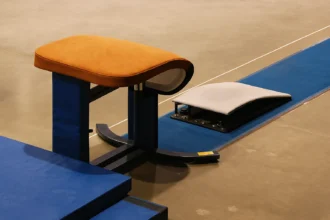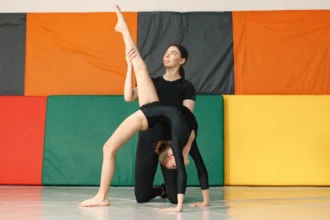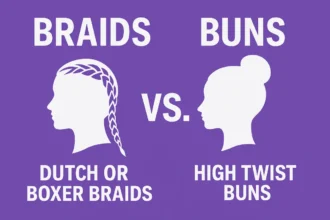Gymnastics scoring might seem mysterious at first, but at its heart is a straightforward concept: each skill in a routine has a difficulty value. The FIG (International Gymnastics Federation) uses an A-to-J scale to assign these values. This guide will break down how the scale works, how values are determined, and why they matter.
What Is the A-to-J Scale?
The A-to-J scale is a system that rates every individual element or skill in a gymnast’s routine by its level of difficulty.
- A represents the simplest skills (each worth 0.1 point).
- The scale climbs with increasing difficulty—B is 0.2, C is 0.3, and so on.
- In men’s gymnastics, the highest rated skill is an I element (0.9 points).
- In women’s gymnastics, some skills go even higher, with a J element valued at 1.0 point.
When a gymnast introduces a new move, it goes through this evaluation process before being added to the Code of Points.
Below is an overview of how each letter corresponds to a point value and examples of skills at that difficulty. Note that actual letter-value assignments can vary slightly between men’s and women’s gymnastics, but the general structure remains consistent.
| Difficulty | Points | General Examples |
|---|---|---|
| A | 0.1 | Forward roll, simple handstand, basic jump (tuck or split) |
| B | 0.2 | Back handspring, front handspring, basic aerial |
| C | 0.3 | Back tuck, round-off series, multi-leap combinations |
| D | 0.4 | Double backflip (double salto), twisting vaults, advanced transitions |
| E | 0.5 | Double backflip with a twist, double layout vault |
| F | 0.6 | Triple twist saltos, more complex release moves on bars |
| G | 0.7 | Double-twisting double back (“double-double”), highly difficult releases or transitions |
| H | 0.8 | Further advanced combos, multi-twist or multi-salto sequences |
| I | 0.9 | Ultra-complex flips/twists; near the upper limit for men |
| J | J (WAG only) | Extremely rare and groundbreaking skills (e.g., Biles II Vault) |
Here’s a closer look at how gymnastics skill difficulty is classified and how the letter system translates into scoring:
A Skills: The Easiest Category
Value: 0.1 points
These are the most basic skills that form the foundation of gymnastics routines. While they require good execution, they do not involve much complexity in terms of acrobatics, twists, or difficult body positions.
Examples:
- Forward roll
- Handstand (held position)
- Simple jumps and leaps (e.g., tuck jumps or split jumps)
In Women’s Artistic Gymnastics, A skills are the simplest and most commonly seen in beginner-level routines. They contribute 0.1 points toward the D-score. Although they are relatively easy compared to higher-level skills, proper form is still crucial for maximizing points.
B Skills: Slightly More Challenging
Value: 0.2 points
B skills are slightly more complex than A skills, often requiring more coordination, balance, or flexibility. These movements may involve some acrobatic elements or basic rotations.
Examples:
- Back handspring
- Front handspring
- Basic aerial (no hands)
In routines, B skills serve as the building blocks for more advanced acrobatic movements. These skills are still relatively straightforward but require a higher level of control and skill compared to A.
C Skills: Moderately Difficult
Value: 0.3 points
C skills are considered moderately difficult. They often require a combination of strength, flexibility, and technical ability. At this level, the gymnast may start incorporating multiple rotations, flips, or more intricate combinations.
Examples:
- Back handspring-back handspring series
- Round-off
- Back tuck (backflip in tuck position)
These skills mark the transition from basic acrobatics to more challenging maneuvers. They contribute 0.3 points to the D-score and are typical in mid-level gymnastics routines.
D Skills: Advanced Elements
Value: 0.4 points
D skills require substantial athleticism and control, often incorporating multiple flips, twists, or dynamic releases. These are typically seen in elite gymnastics, where the gymnast must have advanced technique and strength to execute the skills properly.
Examples:
- Back handspring to back tuck
- Double backflip (double salto)
- Twisting vaults
Gymnasts must have significant skill and preparation to incorporate D-level skills into their routines. These elements elevate the difficulty significantly and contribute 0.4 points to the D-score.
E Skills: High-Level Moves
Value: 0.5 points
E skills are considered high-level gymnastics moves. They require a greater level of strength, agility, and precision. At this level, gymnasts may execute moves involving multiple rotations, twists, or acrobatic sequences that demonstrate impressive skill and control.
Examples:
- Double backflip with full twist
- Double layout vault (two flips and a twist)
- Aerial cartwheel (with a transition into another skill)
These high-difficulty elements are often seen in national or international competitions and contribute 0.5 points or more to the D-score.
F, G, H, and I Skills: Ultra-High-Level Moves
Value: 0.6 points or higher
These are ultra-high-level moves, requiring incredible precision, control, and athleticism. At this level, skills can involve multiple twists, flips, and combinations of acrobatics. They are often groundbreaking moves that push the boundaries of gymnastics.
Examples:
- Triple twisting double backflip (F)
- Double twisting double backflip (double-double) (G)
- Simone Biles’ Yurchenko Double Pike Vault (J) – A double salto (2 flips) with a full twist in a pike position.
These skills are considered exceptional feats of athleticism and contribute significantly to the D-score, with F, G, H, and I skills adding 0.6 points or more. They are generally only seen at the highest levels of competition, and only a few gymnasts in the world can successfully perform them.
How the Difficulty Values Impact D-Score?
In gymnastics, the Difficulty Score (D‑score) is built on the foundation of Difficulty Values. These values, assigned to each skill based on its complexity and risk, form the core of a gymnast’s D‑score. The higher the difficulty value for each skill, the more points are added to the D‑score, which in turn increases the gymnast’s potential for a high overall score.
In addition to the base Difficulty Values, gymnasts can boost their D‑score further by earning bonus points. These bonuses come from two main sources:
- Composition Requirements (CR): Extra points are awarded when a routine includes specific required elements that ensure a well-rounded performance.
- Connection Value (CV): Bonus points are given when skills are linked together seamlessly, without any pauses or breaks in flow.
In men’s routines, the D‑score is calculated by summing the values of the 10 most difficult skills, which allows for a broader accumulation of points. This often results in a D‑score ranging between 5 and 7 points, depending on the routine’s composition. In women’s routines, only the 8 highest-valued elements are counted, so gymnasts often need to include a few ultra-difficult skills or strategically earn bonus points to remain competitive.
Overall, maximizing Difficulty Values—and effectively integrating CR and CV—is essential for gymnasts aiming to achieve a high D‑score and gain a competitive edge in the sport.






